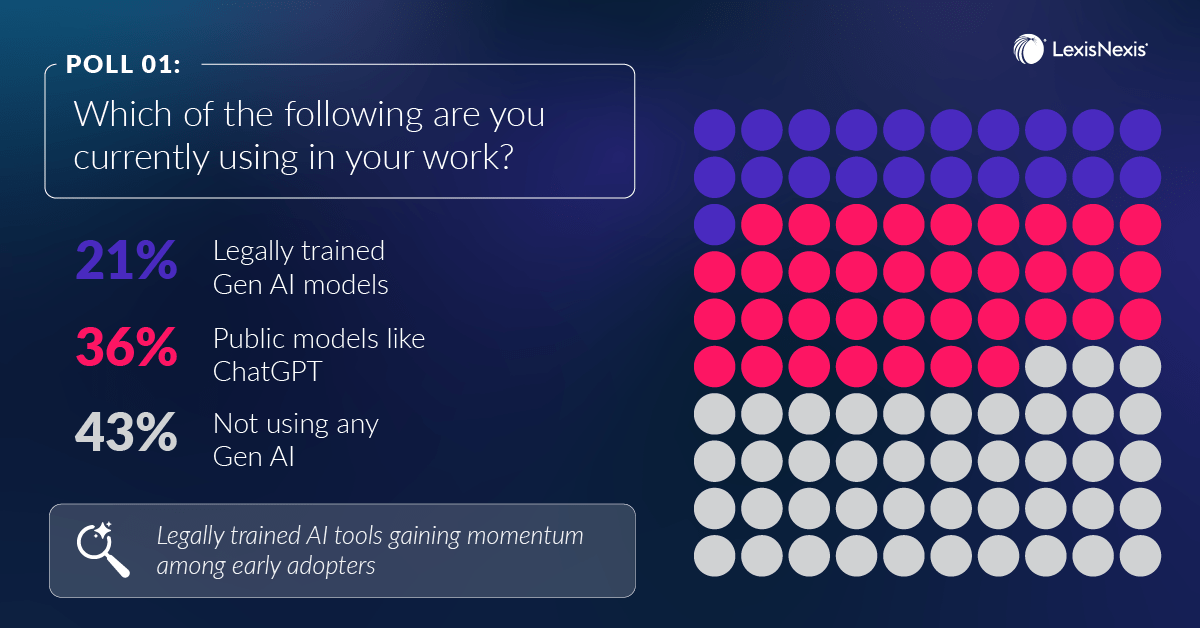Powered by MOMENTUM MEDIA
Powered by MOMENTUM MEDIA
Agentic AI, adoption growth, risk management, and ROI were key themes as legal leaders unpacked how AI is reshaping legal workflows.

Watch on demand webinar for more insight
In a recent LexisNexis webinar, Claire Linwood (Product Manager) was joined by Greg Dickason (CTO for Innovation, Infrastructure, and Operations at LexisNexis) and Nick Abrahams (Global Digital Transformation Leader at Norton Rose Fulbright) to explain recent AI developments and explore what we can expect from legal AI in 2025. The session delivered practical insights into how legal professionals can adopt legal AI today—and prepare for what’s next.
Legal AI is moving fast—and interest is growing even faster. With such rapid developments, it's crucial for legal professionals to understand the underlying technology to make informed, strategic decisions about adoption and implementation.

Greg Dickason explained the concept of agentic AI, distinguishing it from the more familiar generative AI. While generative AI responds to user prompts, agentic AI is goal-driven—capable of planning and executing tasks independently. This marks a shift from reactive tools to proactive digital agents, opening up new possibilities for automation in legal workflows.
Nick Abrahams brought real-world insights from advising law firms and in-house teams. His key message? Focus on problem-first innovation. Instead of adopting AI for the sake of it, legal teams should identify pain points where AI can make a measurable impact—like reducing repetitive tasks, improving research efficiency, or enhancing client service.
AI adoption isn't just a tech decision—it’s a people decision. Leadership buy-in is critical, but as Greg Dickason noted, cultural change can also come from the ground up. Running pilot programs, showcasing early wins, and sharing success stories can help build momentum and encourage wider adoption across the organisation.

Risk management remains top of mind in legal. The panel emphasised the need to use legally trained AI that delivers transparent, referenceable outputs. They discussed tech strategies designed to ensure that AI output is appropriate for legal use cases, like retrieval-augmented generation (RAG) and fine-tuning.
Ensuring data security, compliance, and clear communication with clients will be vital in building trust and mitigating risk.

Calculating the ROI of implementing legal AI tools can be tricky—but not impossible. Nick Abrahams recommended focusing on both cost reduction and client value. From internal productivity gains to enhanced client experiences, showing the tangible benefits of AI will be key to expanding its use and building robust business cases for investment.
The session closed with a look toward the future. As AI capabilities grow, legal professionals have a unique opportunity to transform how they work—streamlining operations, supporting better decisions, and delivering exceptional client outcomes. Staying informed and adopting a strategic, proactive approach will help firms stay ahead of the curve.
Legal AI is no longer a future concept—it’s here. By understanding the technology, identifying the right use cases, and managing change effectively, law firms can lead the next wave of innovation in legal services. The path forward is clear: embrace AI, drive value, and reimagine what’s possible in legal practice.
Watch on demand webinar for more insight.
We're evolving — and so should your insights. Heads up — Lawyers Weekly is going premium from 1 May for just $5 a month. Stay informed without missing a beat. More information coming soon.
